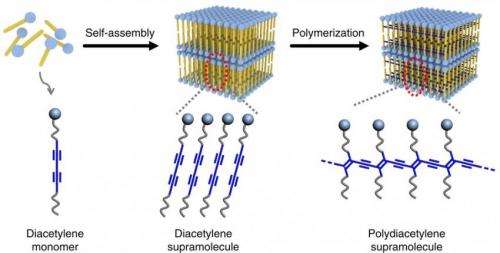April 30, 2014 report
New polymer can be used to map sweat droplets in fingertips for identification purposes

(Phys.org) —A team of researchers working at Hanyang University in Korea has developed a new type of polymer that can be used to map sweat droplets in the fingertips—possibly adding a new tool for forensics use. In their paper published in the journal Nature Communications, the team describes how they developed the polymer, how it works and how it might help law enforcement in the future.
Everyone knows that when people touch things, they leave behind fingerprints—swirls of oils that match the ridges and valleys that make up unique designs and exist on the pads of most every human being's fingers. And fingerprints, have of course, over the years become a very important tool for identifying people at crime scenes. Unfortunately, people don't always leave behind neat prints, and thus, what is found can't be used as evidence. In this new effort, the research team in Korea believes it has created a polymer that can help in such instances.
The polymer they created changes from blue to red when exposed to water—individual polymer units are packed tightly together on a substrate which appears blue. But, because each tiny unit can change on its own, the polymer can be used to test for very small amounts of water—in this case, the extremely small amount of saltwater that creeps out of pores that exist in the valleys of fingertips. Pressing a finger against the polymer causes a red dot to appear wherever there is saltwater from a pore. Taken together, all of the dots form a map that faithfully recreates the contours of the fingerprint.
Scientists already know how to scan for minute traces of sweat from fingertips on materials at crime scenes, until now, however, they had no means for comparing what they'd find with fingerprints taken from a suspect. Now, it appears, they do, and what's more, the technique allows for matching a print to a person even in cases where there were no prints left behind. As an added bonus, sweat left behind on objects lasts longer than oils from fingerprints, which means the new technique might even prove useful in cases that have lain cold for up to a decade.
More information: Hydrochromic conjugated polymers for human sweat pore mapping, Nature Communications 5, Article number: 3736 DOI: 10.1038/ncomms4736
Abstract
Hydrochromic materials have been actively investigated in the context of humidity sensing and measuring water contents in organic solvents. Here we report a sensor system that undergoes a brilliant blue-to-red colour transition as well as 'Turn-On' fluorescence upon exposure to water. Introduction of a hygroscopic element into a supramolecularly assembled polydiacetylene results in a hydrochromic conjugated polymer that is rapidly responsive (<20 μs), spin-coatable and inkjet-compatible. Importantly, the hydrochromic sensor is found to be suitable for mapping human sweat pores. The exceedingly small quantities (sub-nanolitre) of water secreted from sweat pores are sufficient to promote an instantaneous colorimetric transition of the polymer. As a result, the sensor can be used to construct a precise map of active sweat pores on fingertips. The sensor technology, developed in this study, has the potential of serving as new method for fingerprint analysis and for the clinical diagnosis of malfunctioning sweat pores.
Journal information: Nature Communications
© 2014 Phys.org





















